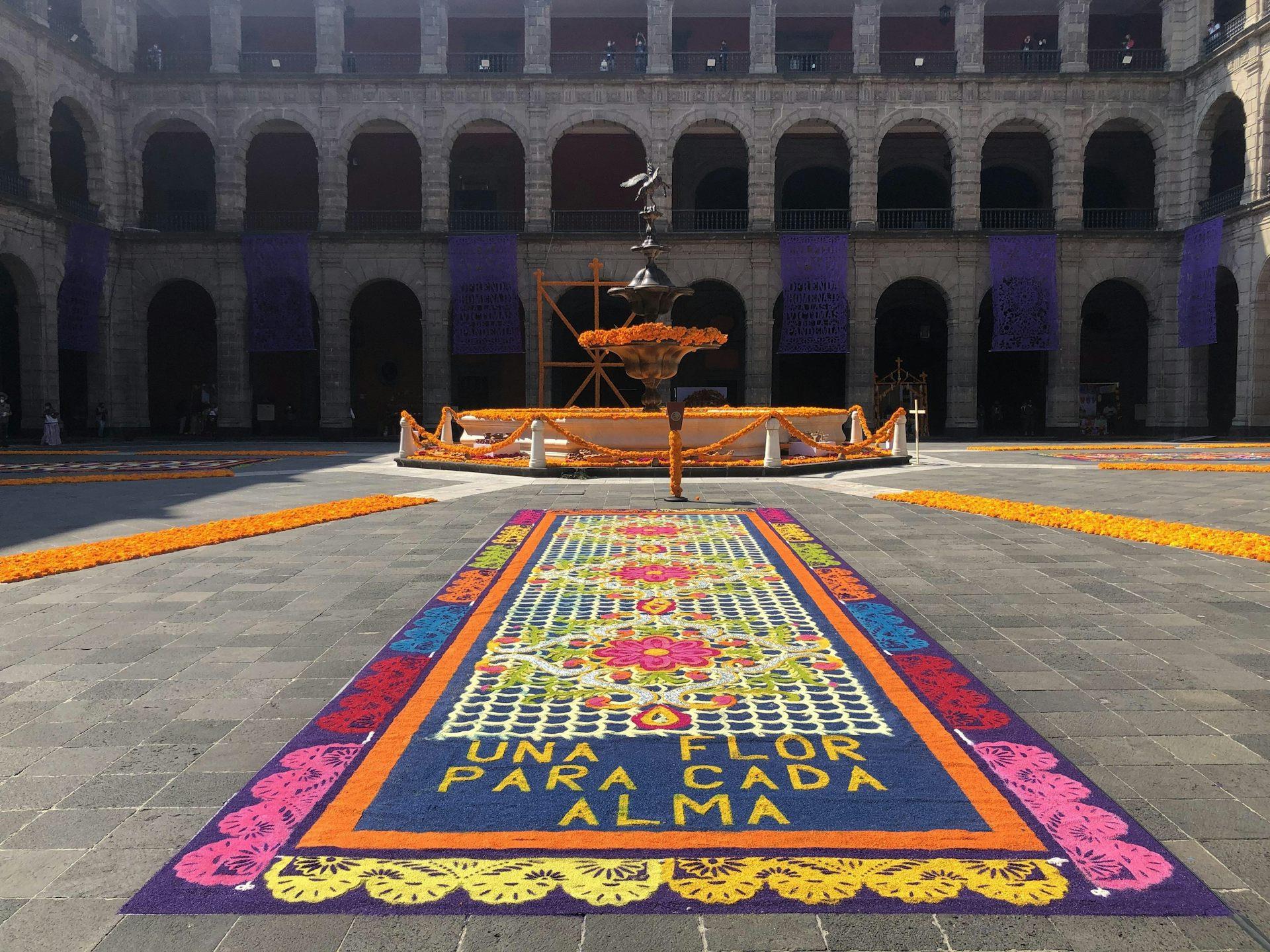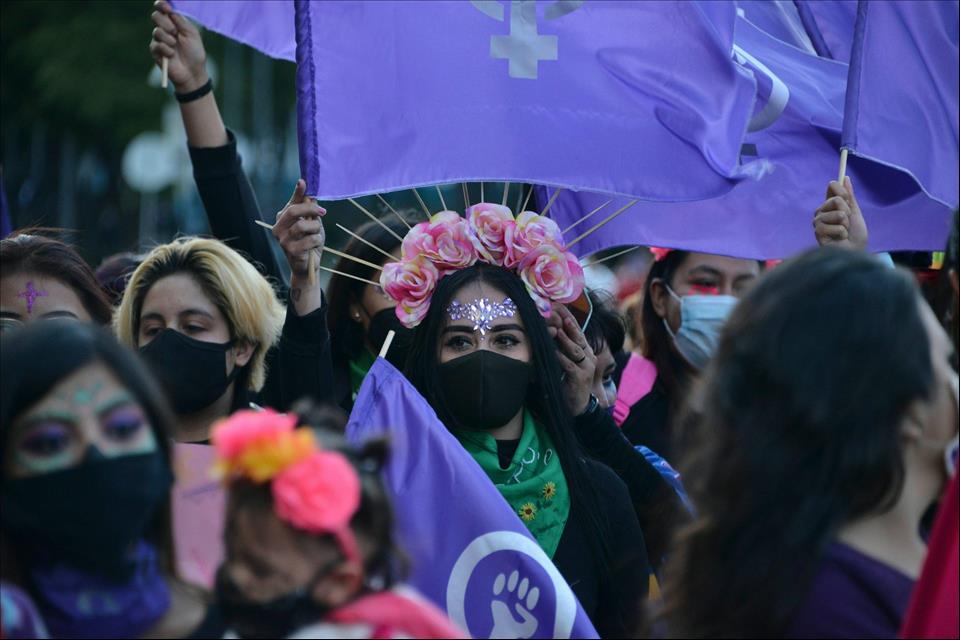
How The Day Of The Dead Is Being Used To Protest Violence Against Women
Enjoying a festive atmosphere, people build altars or visit cemeteries where they bring flowers and picnics, light candles and celebrate cherished relatives with storytelling and song.
The ritual is celebrated globally by many migrant Mexican and non-Mexican communities, and is in a process of continual reinvention responding to different social and cultural needs.
For example, during the COVID pandemic, women leaders from Mexican migrant communities in the UK and Ireland organised Day of the Dead events to celebrate their heritage and remember those who had succumbed to the virus. Elsewhere, a youth group in the US reimagined Día de Muertos as an expression for healing in their community following the killing of George Floyd.
The celebration has also been co-opted by Mexican grassroots feminist organisations protesting against gender-based violence, as our new book, Changing Configurations of Día de Muertos During the COVID-19 Pandemic in Mexico and Beyond, explores.
With a focus on the tumultuous pandemic years of 2020-21, the book charts how the Day of the Dead evolved and changed in that period. These adaptations were also shaped by global anxieties surrounding the so-called“shadow pandemic” – a term used to describe the surge in gender violence over the same period.

A floral tribute outside the presidential palace in Mexico City pays tribute to those who died during the pandemic, when levels of domestic violence soared. Newscom / Alamy La Catrina
The Day of the Dead is associated with the iconic image of the Catrina, depicted in the world-famous illustration La Calavera Garbancera (1910) by artist José Guadalupe Posada. Inspired by Mictēcacihuātl, the Aztec goddess of death, today the Catrina is probably Mexico's most commodified visual emblem.
Since 2016, Mexico City's spectacular Mega Desfiles de Catrinas y Catrines parade has also drawn millions of people, with women dressed in traditional Catrina costumes and men wearing skeleton-themed formal attire.
The Catrina has proved an appealing inspiration for women seeking to protest against the unacceptably high levels of gender-based violence in Mexico. The country has one of the highest rates of femicide in the world – a term used to denote deadly violence against women because of their gender.
Alongside the glitzy parade is an alternative event called the Marcha de las Catrinas. In Mexico City, this march follows a route between two monuments dedicated to female victims of violence, starting at the Glorieta de las Mujeres que Luchan on Avenida Reforma and ending at the Anti-monumenta on Avenida Juárez.
There, protesters erect marigold-adorned altars and crosses bearing victims' names, and post messages of solidarity. But unlike the traditional marigold and monarch butterfly-decorated Catrina costumes, many marchers wear dresses covered in photographs of murdered or missing women and girls.
La Catrina has become a symbol of female Mexican identity. Guadalupe Posada / ArtDaily Día de Muertos and the missing voices
Such was the momentum to channel the Day of the Dead to protest against gender-based violence in Mexico that a specific Día de Muertas (day of the dead women) was proposed by the NGO Voces de la Ausencia (the missing voices), led by journalist Frida Guerrera and held since 2018.
During the COVID pandemic, social distancing measures intended to protect public health inadvertently created conditions that increased the vulnerability of women and girls by sometimes isolating them with abusers and limiting access to support services.
Feminist protests held during these years were both national and international in scope, signalling global anger at the explosion in violence triggered by lockdown policies and social isolation. A strong intergenerational dimension characterises the collective resistance, as was attested by activist Norma García Andrade during the Marcha de las Catrinas in 2020:
The practice of taking up public space with one's own body to protest gender-based violence – known as acuerpamiento – has increased in intensity in Mexico, and is best showcased during International Women's Day marches every March. Channelling an intergenerational rage, in 2020 and 2021 women dressed as Catrinas adorned themselves with feminist fist symbols and slogans such as #TruthAndJustice, #Niunamás (not one more) and #Nuncamas (never again).
Young women in Mexico are angry at the unacceptable levels of violence against women. The Photo Access / Alamy
Some wore green scarves around their necks, advocating for the decriminalisation of abortion – an increasingly prominent symbol of international feminist activism across Latin America. Many Catrinas lay on the ground emulating dead corpses, surrounded by marigolds and with photos of the victims placed on altars.
These interventions use what Hispanic studies scholar Francesca Dennstedt calls tactics of feminist disappropriation, and resonate with feminist anthropologist Rita Segato's ideas around performative disobedience.
With this takeover of public space by protesting Catrinas, these feminist groups re-imagine Mexico's most visually alluring representation of death for a 21st-century global audience.

Legal Disclaimer:
MENAFN provides the
information “as is” without warranty of any kind. We do not accept
any responsibility or liability for the accuracy, content, images,
videos, licenses, completeness, legality, or reliability of the information
contained in this article. If you have any complaints or copyright
issues related to this article, kindly contact the provider above.


















Comments
No comment